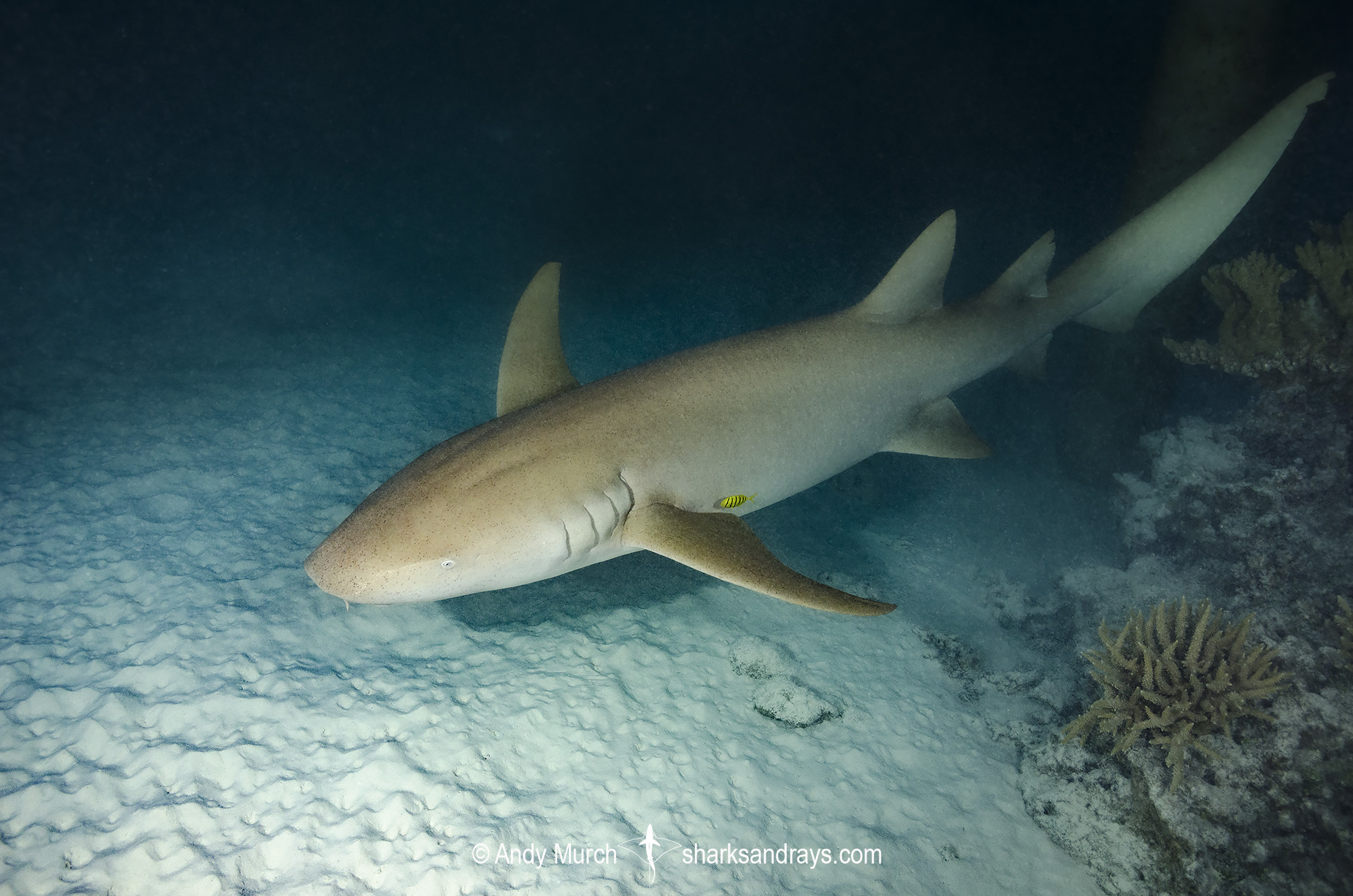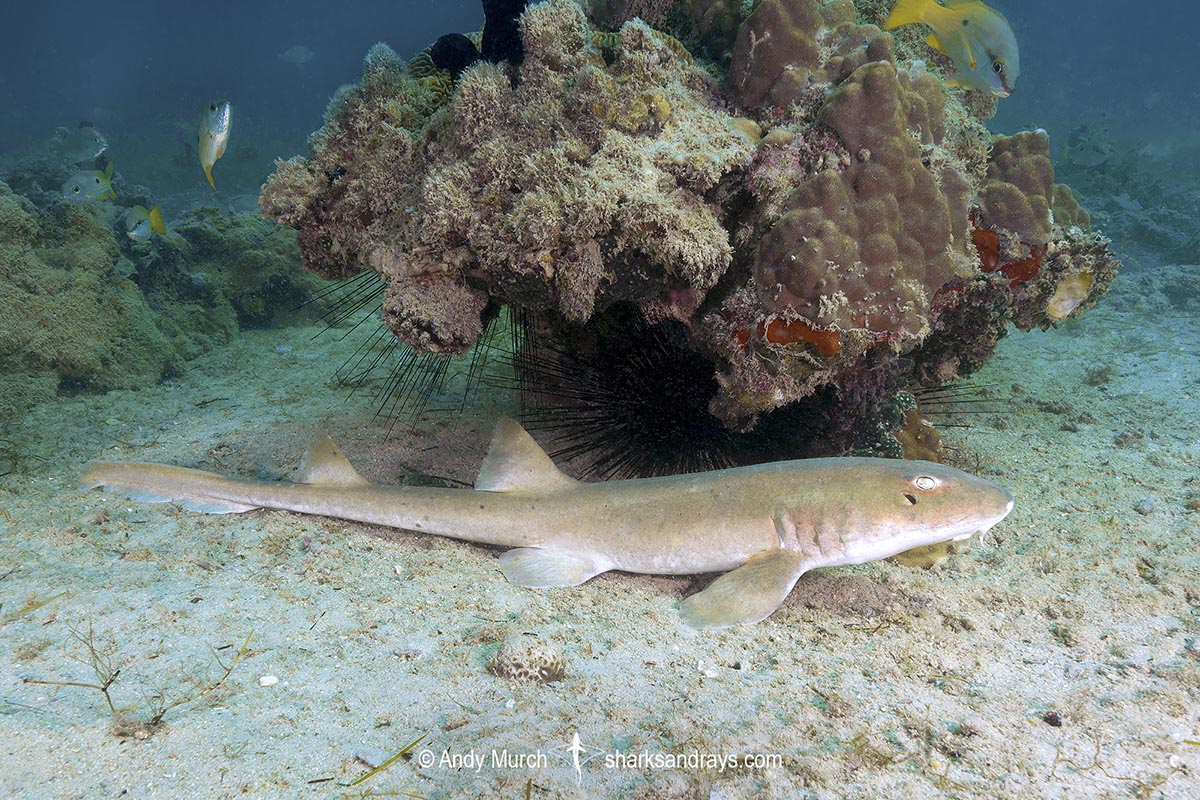Common names
Tawny Nurse Shark, Nurse Shark.
Binomial
Nebrius ferrugineus.
Synonyms
Ginglymostoma concolor, Ginglymostoma ferruginaea, Ginglymostoma ferruginea, Ginglymostoma ferrugineum, Ginglymostoma muelleri, Ginglymostoma rueppellii, Nebrius concolor, Nebrius doldi, Nebrius ferrugineum, Nebrius macrurus, Nebrodes concolor ogilbyi, Nebrodes macrurus, Scyllium ferrugineum, Scymnus porosus.
Identification
Head broad. Snout short and bluntly rounded; pointed when viewed laterally. Mouth small. Nasal flaps form long, thin barbells. First dorsal fin positioned far back on body; origin over pelvic fin origin. Second dorsal large but smaller than first. Second dorsal origin over anal fin origin. Lower caudal lobe indistinct. Caudal fin very long with a small terminal notch close to the tip.
Dorsal coloration tan to dark brown. Ventral surface pale.
Size
Maximum recorded length 320cm. Size at birth 40-60cm.

Conservation Status
VULNERABLE
The Tawny Nurse Shark (Nebrius ferrugineus) is targeted and a bycatch species in longline, gillnet, handline, and demersal trawls throughout much of its range. It is also threatened by reef degredation caused by climate change and destructive fishing practices. In Asia and Africa, severe declines have occurred but it remains common in Australia, southern Red Sea and in many the island nations of the Pacific and Indian Oceans where shark fishing is prohibited. It is estimated that the Tawny Nurse Shark population has been reduced by 30–49% in the last 90 years.

Habitat
A tropical species preferring shallow sandy bays, coral reefs, and sea grass beds. estuaries, eelgrass beds, and rocky reefs. Usually found on or near the bottom from close inshore to at least 70m.
Distribution
The tawny nurse shark is found throughout the tropical Indo-Pacific as far east as the Society Islands in French Polynesia. It is absent from the eastern Pacific. In the Indian Ocean it is found from South Africa to the Red Sea, around Madagascar, India, Southeast Asia, and northern Australia.
Reproduction
An aplacental viviparous species (without a yolk-sac placenta). 4-8 pups per litter. Fetuses are oophagous; consuming unfertilized eggs once their yolk sac has been depleted.
Diet
The Pacific nurse shark preys on a wide variety of invertebrates (corals, crustaceans, cephalopods, etc) small fishes, and occasionally sea snakes.
Behavior
Pacific nurse sharks are often found resting in small groups. They are nocturnal hunters that use their powerful pharynx muscles to suck prey out of holes in the reef.
Reaction to divers
Very easy to approach when resting under reef ledges.
Diving logistics
Pacific nurse sharks are quite common throughout their range and are easily encountered in numerous countries.
In Australia, one of the best places to look for them is Lady Elliott Island off the coast of Queensland. They are also common off of Exmouth and on Ningaloo Reef.
What’s new
View our full list of updates
Similar species
Arabian Carpetshark Distinguished by smaller size, more slender appearance and much greater relative distance between the pectoral fins and caudal fin.
Brownbanded Bamboo Shark Distinguished by smaller size, more slender appearance, greater relative distance between the pectoral fins and anal fin. A rounded anal fin, and rounded caudal fin tips.


